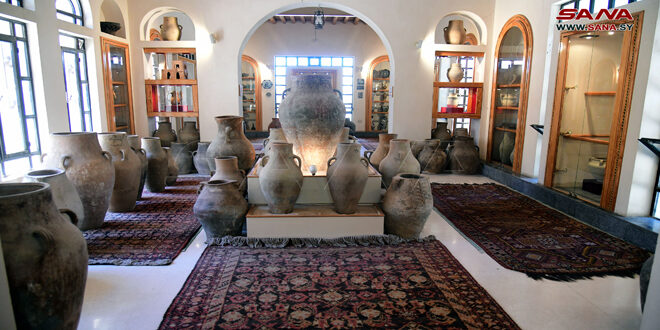The Museum of Deir Atiyah is one of the biggest and richest museums in Damascus countryside. It contains the heritage and folklore of the region.
The Museum is situated close to the peak of Tal Al Malih.
The corridors and walls of Deir Atiyah Museum show a distinctive architectural art and a clear imprint of the high level of architecture and heritage in Syria and the region. The museum is considered as one of the most important Syrian museums as it is distinguished for its rich archeological and historical heritage, starting from its unique location, architectural structure and engineering design, all the way to its diverse and valuable contents.
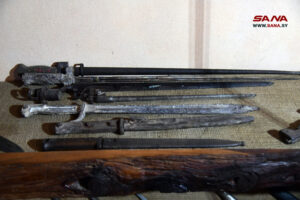 The museum features collections of important national and historical symbolism. The civil society has contributed to enriching its ten sections since its establishment in 1991, which contributed to increasing the number of artifacts to more than 108 thousand pieces.
The museum features collections of important national and historical symbolism. The civil society has contributed to enriching its ten sections since its establishment in 1991, which contributed to increasing the number of artifacts to more than 108 thousand pieces.
The museum seeks to achieve cultural development, and provides an opportunity for learning and live communication with cultural heritage, as it enables visitors to explore history and art through exhibits. In addition, the museum plays essential and important role in raising cultural awareness and enhancing social cohesion, noting that the museum represents a witness to Syria’s history and culture and embodies a unique model of heritage and architecture.
The museum covers an area estimated at 15,000 square meters and consists of ten buildings, in addition to the castle building, all of which were built in several stages, in addition to the garden, which in itself is considered an open-air museum. This garden contains large pieces of antiquities that are difficult to move.
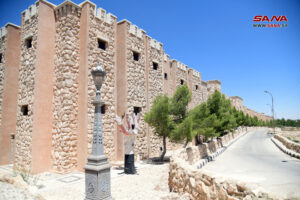 The museum’s cave contains of flint stone pieces and collectibles dating back to approximately a thousand years BC, including stone axes, arrows, and sickles used by ancient man in the Stone Age for hunting, cutting crops, and other daily uses. These objects were discovered in an areas in Yabroud and Maaloula.
The museum’s cave contains of flint stone pieces and collectibles dating back to approximately a thousand years BC, including stone axes, arrows, and sickles used by ancient man in the Stone Age for hunting, cutting crops, and other daily uses. These objects were discovered in an areas in Yabroud and Maaloula.
What makes this Museum distinguished from other ones is its special style of construction and architecture, besides its sections which were distributed according to various historical stages.
After it was vandalized and stolen by terrorists in 2013, the museum was liberated and later, several sections in the museum were rehabilitated and the artifacts returned to decorate the place alongside other heritage collections.
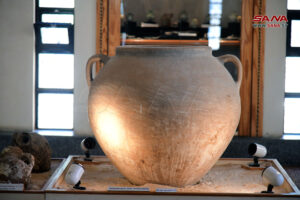 The museum’s castle, which was built over a period of thirteen months and within various historical stages, embodies the museum’s steadfastness in the face of challenges.
The museum’s castle, which was built over a period of thirteen months and within various historical stages, embodies the museum’s steadfastness in the face of challenges.
The unique Mamluk wooden ceilings that the museum contains are the oldest archaeological ceilings in Syria, as they were transferred from an ancient house in Deir Atiyah and reinstalled as they were in one of the museum’s halls.
The museum’s divisions and display method were based on artifacts and their historical historical stage, which distinguished each section separately.
The museum’s exhibits are made of various materials that were used in ancient times, such as pottery and glass, and were displayed according to a historical sequence, starting from the Bronze Age to the Iron Age, passing through the Hellenistic, Roman, Byzantine and Islamic eras, in addition to collectibles and tools that indicate popular traditions.
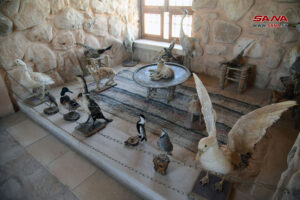 The museum’s sections also display pottery vessels from inside and outside the region, some of which were found in Tel Saka in the Ghouta of Damascus, and others are dating back to the seventh century BC, found in Tel al-Hamira, which is located to the northeast of Deir Atiyah.
The museum’s sections also display pottery vessels from inside and outside the region, some of which were found in Tel Saka in the Ghouta of Damascus, and others are dating back to the seventh century BC, found in Tel al-Hamira, which is located to the northeast of Deir Atiyah.
The museum includes hand-made ceramic and silver works from outside Syria, as well as Roman and Byzantine statues and stone and gold artifacts, Roman and Byzantine stone sculptures and decorations, including Roma, Byzantine and Islamic basalt sculptures and doors that were used to close underground tombs, in addition to ancient Islamic bronze vessels.
It also includes ancient manuscripts, contracts, ownership certificates, letters from the Deir Atiyah sons abroad, pieces used in agriculture and harvesting, tools that met the needs of the people in Qalamoun region in the past, tools used in many other professions, in addition to textiles, fabrics and handmade collectibles used in weaving carpets and rugs.
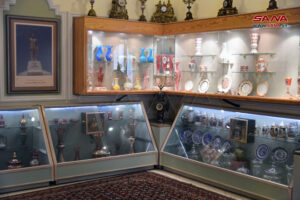 Some sections contain valuable glass and ceramic objects that are distinguished by their high artistic form, drawings and decorations, in addition to ancient swords, daggers and military weapons that were used in hunting, various types of recorders and old telephones, mosaic works, oil paintings, documents and writings of some national figures, and some watches and distinctive pieces of art.
Some sections contain valuable glass and ceramic objects that are distinguished by their high artistic form, drawings and decorations, in addition to ancient swords, daggers and military weapons that were used in hunting, various types of recorders and old telephones, mosaic works, oil paintings, documents and writings of some national figures, and some watches and distinctive pieces of art.
Raghda Sawas

